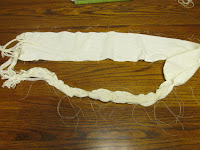On completion of the day some of the floor loom weavers were finished their 60" scarf - I, using my table loom was just on 40" for the day, which I thought was fairly good. It then took another couple of hours to finish off to the required length.
 |
| Tabby ground in 8/2 cotton and nylon pull threads in a monk's belt pattern |
Once hem stitched and removed from the loom the work involved knotting all down one side first and then pulling the other side tight to form ripples in the tabby ground which would form the 'resist' when dyed.

Fat fingers and thin nylon is not a great combination, but eventually I had it all knotted and tied up tight.
The next step for the other participants will be to dye their tied up warps with an indigo dye pot that I will be bringing along to the meeting this Saturday. I however, was able to dye my own warp by bringing back to life the dye pot from over a year ago (next blog). The warp was soaked in water overnight while the dye pot awoke, and with two 5 minute dips and 15 minutes after each to oxidize the results were pretty good.
 |
| The dyed and rinsed scarf. |
 |
| Close up of the shibori pattern |

No comments:
Post a Comment